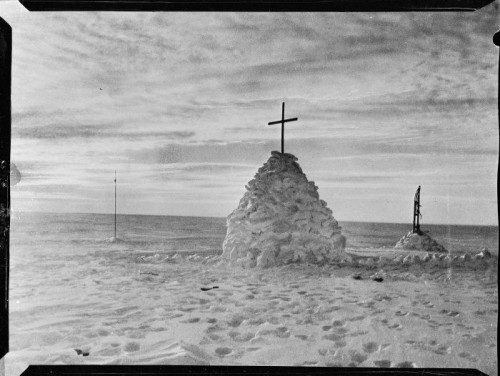
Cairn marking the site of Robert Falcon Scott's tent, 1912. Petty Officer Edgar Evans died in February 1912; Scott and the remainder of his party died during March. The bodies of Scott, Dr Edward Wilson, Lieutenant Bowers were eventually found in their tent by a search party in November 1912. It was a number of months before the news reached New Zealand.
New Zealanders learn of Robert Falcon Scott's death
By early April 1912 New Zealanders were aware that the Norwegian explorer Roald Amundsen had beaten Britain's Captain Robert Scott to the South Pole. But there was continued interest in Scott's own bid for the Pole. The British Antarctic Expedition's vessel, the Terra Nova, was expected to return in March or April 1913. So when it arrived in Oamaru on 10 February 1913, well ahead of schedule, there was speculation that some disaster had befallen the expedition. A copyright agreement that prevented expedition members from being immediately forthcoming with news only increased the speculation. Within 24 hours New Zealanders learnt the truth - Scott and his polar party had made it to the Pole, only to perish on their return journey. When the Terra Nova arrived in Lyttelton on 12 February 1913 it found a town in mourning.
Scott beaten to Pole by Amundsen
Just under a year earlier, on 1 April 1912, the Terra Nova had arrived in New Zealand with news that the world had been waiting for - confirmation that Scott had not reached the Pole before Amundsen. The returning party reported that when the last supporting party turned back on 3 January 1912, Scott and his party were within 240 km of the Pole. It was estimated they would reach the Pole by 17 January. But Amundsen had already made it on 14 December 1911.
Despite some disappointment at this news, 40 people farewelled the Terra Nova when it left Lyttelton at 5 a.m. on 14 December 1912. It was expected that the vessel would return with Scott's party in March or April 1913. The expedition would stay on in the Antarctic for the summer, to explore if the bid for the Pole had been successful, or, if it had failed, to make another attempt.
Speculation on fate of Scott's polar party
The Terra Nova returned early in February 1913 to report that Captain Scott, Dr Edward Wilson, Lieutenant Henry Bowers, Captain Lawrence Oates and Petty Officer Edgar Evans had made it to the Pole but perished on their return journey. But an agreement with the Central News Agency in London, and concern that relatives should be informed, meant that the two men who went ashore at Oamaru did not speak of the tragedy, except in strict confidence. They arranged for a coded message to be sent to Joseph Kinsey, the expedition's New Zealand representative, and then went by train to Christchurch to meet the Terra Nova. The vessel, which had the remaining expedition members on board, headed for Lyttelton, but was required to stay at sea for 24 hours after the cable was sent.
The press and public spent the day speculating on the cause of the Terra Nova's early return, with rumours fuelled by a lack of official comment from Kinsey. On receiving the news from Oamaru, he had cabled the Central News Agency. It wasn't until the morning of 11 February that news of the tragedy filtered back to New Zealand from London. It made the evening papers that day, and was reported elsewhere the following morning. When the Terra Nova sailed into Lyttelton at 10 a.m. on 12 February with flags at half mast it found a people in mourning - New Zealanders responded as if the men were their own.
Scott's wife hears of his death on voyage to New Zealand
As the country and empire mourned the loss of Scott and his party, and began holding memorial services in their honour, Scott's widow, Kathleen, was still unaware of the tragedy. She was sailing to New Zealand in anticipation of her husband's victorious return in March or April. She was told on 19 February by the captain of the ship on which she was travelling.
Kathleen Scott and Oriana Wilson, who lost her husband, Dr Edward Wilson, in the tragedy, were thankful for the support they received from New Zealanders. They co-signed the following message:
Before leaving this country we would like to express our very real gratitude to the Government and people of New Zealand for their sympathy and thoughtful help to us. The forethought for our welfare had touched us deeply and will not be forgotten.
Kathleen Scott, a sculptor, was subsequently commissioned by Christchurch City Council to complete a statue of Scott. It stands on the corner of Worcester St and Oxford Tce, Christchurch.
Further information
Books
- Apsley Cherry-Garrard, The worst journey in the world, New edition, Chatto & Windus, London, 1965
- Gavin McLean, Kiwitown's Port, Otago University Press, Dunedin, 2008, p. 84
- L. B. Quartermain, New Zealand and the Antarctic, A R Shearer, Government Printer, Wellington, 1971
- Max Jones, The Last Great Quest, Oxford University Press, Oxford, 2003
- Ranulph Fiennes, Captain Scott, Hodder & Stoughton, London, 2003
Links
- Terra Nova Expedition (Wikipedia)
- Robert Falcon Scott (Wikipedia)
- Captain Scott (National Maritime Museum)
- Robert Falcon Scott (south-pole.com)
- Kathleen Scott (Wikipedia)



Community contributions